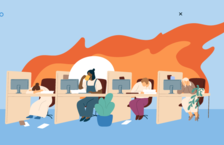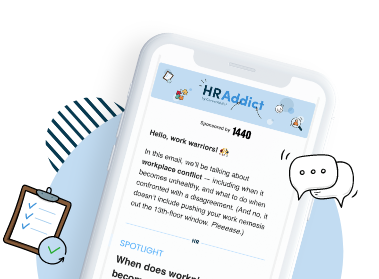When we’re at work, we’re impacted by so much more besides the style of the job we do and the physical environment we operate in. Every workplace is shaped by behaviors — our own and those of the people around us — and these can have positive impacts on our job satisfaction but can detract from it too.
It’s vital for all employees, recruiters and managers to be aware of these behaviors, and what should be sustained or what should be managed or removed. This article is a comprehensive guide through the most prevalent types of behavior at work. We will discuss what they are and how they impact your workplace environment.
1. Leadership
Whereas organizations can function effectively without a leader, effective leadership takes them to the next level.
Leadership provides long-term direction in terms of goals, vision and financials. A great leader can also get the most out of their people, finding synergies and enhancements that a poor leader or an absence of leadership will not. Effective leadership will also drive loyalty: great employees are loyal to great leaders, and clients can be loyal to them too.
2. Accountability
Accountability breeds responsibility, and workplaces that take responsibility will get more done, in the right way. Accountable employees will show pride and care in their work, lowering the chances of mistakes.
They will also be more efficient, trying to get more work completed and coming up with new ideas to work smarter. Finally, accountability means that employees will be honest and fair, believing in diligently reporting issues or errors and completing work ethically and to the right standard.
3. Creativity
Creative behavior in the workplace generates ideas and solves problems. It’s a great way to drive innovation and find competitive advantage. Creative employees are excellent at thinking outside the box, which can lead to gains in productivity.
Creativity needs to be managed well. If it isn’t, then sometimes conflict can arise, or time is wasted on unrealistic ideas or ones that will not take off due to resource constraints.
4. Passiveness
Passiveness in the workplace refers to a reluctance to speak up or take charge. Passive behavior can help with avoiding conflict and contribute to a positive working environment, but it’s important to acknowledge that it can also work against the organization.
It can lead to a lack of teamwork, productivity and slow decision-making. Passive managers will be perceived as not fully developing or utilizing their team’s talents to the best of their abilities.
5. Collaboration
Collaborative behavior fosters teamwork and brings together different people with diverse ideas, capabilities and viewpoints. As such, it’s a powerful behavior to develop and is great for improving problem-solving and driving innovation.
Collaborative teams are often effective communicators as well, though if collaboration is not managed effectively, it can lead to miscommunication, conflict, and teams that get stuck in the “storming” stage.
6. Absenteeism
Whereas some absence is inevitable, and people staying home sick is better than them coming in and passing contagious illnesses to others (“presenteeism”), high absenteeism at work is a sign that all is not well.
Habitual absence disrupts workflow, contributes to stress and delays, and can ultimately lower morale. Absenteeism can also reduce profitability through the cost of replacing someone who is sick, overtime payments and lack of productivity.
7. Bullying
Bullying behavior is the harassment, belittlement or intimidation of others. This creates a hostile and toxic work environment that reduces morale and increases the likelihood of turnover.
In some jurisdictions, organizations that fail to address bullying can leave themselves vulnerable to litigation. Ultimately, bullying can decrease productivity and contribute to absenteeism, and therefore should be proactively addressed at all times.
8. Gossiping
Gossiping is the classic office trait of spreading rumors or discussing others behind their backs. It might seem harmless, but it can reduce collaboration, and increase conflict by fostering distrust and creating rifts between employees.
Gossiping can lead to bullying and create a hostile work environment. It can contribute to poorer business performance through lower productivity, higher costs and reduced employee engagement. If not addressed, it can ultimately become an unwanted element of your organizational culture.
9. Aggressiveness
Not to be confused with assertiveness, aggressive behavior is forceful or domineering behavior that negatively affects others. It can lead to conflicts and high stress levels, and can cause talent to leave.
Aggressive workplaces can become aggressive cultures through the behavior becoming ingrained into the environment. Whereas an aggressive personality can in moderation contribute to achieving goals, especially in critical or high-pressure settings, this behavior needs to be carefully managed at all times.
10. Introversion
Introverted behavior is when people work in a reflective and reserved way, often independently. Introverts can bring a lot to the workplace through analytical thinking, focus and care, and can thrive in environments that require these traits.
However, if an organization is overtly introverted, this can impact communication, teamwork and creativity through less willingness to openly discuss projects and opportunities.
11. Adaptability
Adaptable people cope well with change; they can adjust to new projects, work styles and environments. Adaptability benefits the workplace by improving its ability to be agile and remain competitive, as well as encouraging employees to be resilient, maintain quality of work and motivate each other to manage through change.
Unfocused adaptability and poor change management can lead to a lack of direction or confusion, and hinder the organization from achieving its goals.
12. Reliability
Reliable behavior means that organizations and their employees are adept at meeting deadlines, performing jobs as expected and achieving targets. Consequently, this behavior drives trust, loyalty, a strong team culture, and work ethic.
Reliable employees are often seen as the cornerstone of every successful organization, but managers should take care not to rely on them too much in case they burn out or leave.
13. Analytical
Analytical behavior involves the use of logic, reasoning, data analysis and critical thinking to work through organizational challenges. This creates a methodical and accurate approach to decision-making and problem-solving. Analytical behavior can even contribute to team development through analytical employees breaking down projects for others.
However, too much analytical thinking can lead to “analysis paralysis”, where decision-making slows down and organizational agility is impacted.
14. Dominance
Dominant behavior is where individuals take charge and control people or teams, sometimes excessively so. This can be a double-edged sword; benefiting the organization through swift and decisive decision-making and establishing a clear “line of command”.
The flip side of dominant behavior is that it can degrade into harassment, creating a hostile work environment or one where employees are fearful of speaking up or sharing ideas. This stifles creativity and can lead to teams breaking down.
15. Playfulness
Playfulness is a trait that, when incorporated into work, encourages creative thinking and innovation, as well as contributes to stress management and wellbeing. It also drives teamwork and collaboration.
That said, when it is relied upon too much or distracts from the organizational mission, it can decrease productivity and, in very rare cases, contribute to unwanted behaviors such as bullying or harassment.
16. Motivated
Motivated employees drive themselves to work hard and to a high standard, achieve goals, contribute to the organizational culture, and help their colleagues. Organizations that prioritize a culture of motivation can therefore expect to see productivity and profitability increase, as well as creative thinking and collaboration.
Motivation needs to be aligned with company goals and rewarded appropriately. If it isn’t, people can become demotivated very quickly, leading them to resign or put in less discretionary effort.
17. Assertiveness
Assertive behavior in the workplace involves confidently expressing opinions and driving for results while respecting other people. This behavior can keep communication clear and on track, stimulate creativity through the open sharing and critique of ideas, and prevent small conflicts from becoming larger.
As mentioned earlier, assertiveness can be confused with aggression and can slide into the latter when it’s not properly managed or if conflict is allowed to fester within teams.
18. Extraversion
Extraverted behavior is evidenced through sociable employees, high enthusiasm and outward motivation, and people being happy and willing to interact with others. Consequently, extraversion drives communication, teamwork and a happy work environment.
In organizations that prioritize relationship management and collaboration, extraversion works very well. Leaders need to ensure that the needs of introverts are managed as well, as extroverts can unknowingly dominate their more solitary and calmer coworkers.
19. Integrity
Integrity in the workplace involves employees working honestly and consistently, making fair decisions, and fostering trust and openness in all that they do. This behavior is essential for driving transparency, accountability and sustainability: traits valued by clients, customers and even regulators.
Managing integrity might require tough decisions, such as giving constructive feedback, challenging assertive employees making poor decisions, or saying “no” to making fast money if doing so is ethically dubious. Therefore, integrity needs to be led from the top, by strong, equitable management.
20. Respectful
Respectful behavior in the workplace involves treating everyone fairly and appropriately, as we would like to be treated ourselves. Respectfulness creates a positive work environment, drives collaboration, and contributes to effective conflict management.
Respectfulness is also essential to diversity, equality and inclusion initiatives, which can contribute to high trust, diverse teamwork, employee engagement, and opening paths to innovation and creativity.
Final thoughts
Many workplace traits have positive and negative attributes. They work in various and complex ways within your organization and, over time, can become part of its ingrained culture and values. Depending on the type of behaviors and how they are manifested, their impact can be either beneficial or create difficult employees.
Organizations must be constantly aware of the behaviors present in their workplaces and manage these accordingly, rewarding and sustaining good attributes and managing any negative influences. Doing this will ensure your organization will be regarded by current and prospective employees as a place to work that is positive and productive, and develops its people well.
This article is a complete update of an earlier version originally published back in 2015.

